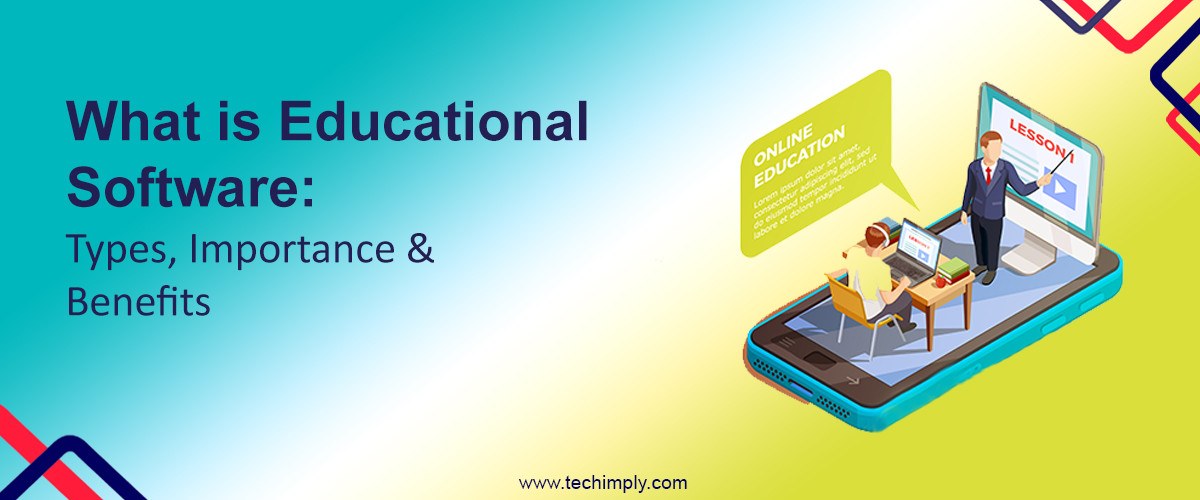Educational software has become an integral part of businesses worldwide, as they continually integrate IT innovations within their operations. However, it's not just businesses that are reaping the benefits of these advancements. The education sector is also significantly benefitting from the emergence of educational software that offers both online and offline learning experiences. There is a continuous influx of new Educational Software to meet the needs of individual learners and educational institutions alike.
Such applications deliver a dynamic and engaging user experience that caters to teachers and students. Elearning software development comes with several advantages, the most prominent being cost-effectiveness for district schools and other educational establishments. So, let's delve deeper into the various types of educational software available today.
Educational Software: What You Need To Know
Best Educational Software stands as a cornerstone in the realm of learning, encompassing a suite of purpose-built software tools aimed at enhancing teaching and learning experiences. These digital instruments open the door to novel, engaging, and interactive methods of knowledge transmission. The spectrum of these tools is broad, encompassing elements like interactive games, immersive simulations, reference tools, AI homework helpers, and learning management systems, each uniquely designed to enrich and streamline the educational process.
The significance of educational software is monumental, as it can adapt to individual learning styles, monitor academic progression, and craft personalised learning trajectories. It's a game-changing tool that's revolutionising the educational space. In this blog, we will unfold the complexities of educational software, exploring its myriad types, the benefits it brings, and its importance in today's educational panorama.
Types of Educational Software
Educational software in India can be segregated into various categories based on their purpose and functionality. Here are a few examples:
-
Educational Games: Always a favourite among learners, games have been utilised to stimulate student engagement. Technological advancements have revolutionised educational games, making them more immersive and interactive. They span multiple subjects, like mathematics, science, language arts, and history. They transform learning into an enjoyable activity, aiding students to remember the information more efficiently.
-
Reference Software: This type of software includes digital resources like encyclopaedias, dictionaries, and other informative tools, offering students rapid access to data. These tools are invaluable for conducting research, and providing reliable and current information instantly.
-
Simulation Software: Simulation software empowers students to immerse in real-life situations within a virtual setting. Fields such as engineering, medicine, and aviation often utilise this type of software to offer practical learning experiences without any actual risks or consequences.
-
Multimedia Software: This category includes tools like videos, animations, and presentations that make education more engaging and interactive. It accommodates various learning styles and can be employed across different subjects to visually illustrate complex concepts.
-
Assessment Software: This software is devised Online assessment software to gauge students' comprehension, knowledge, and abilities. It comprises quizzes, tests, and other tools, providing real-time feedback to help students monitor their progress and pinpoint areas requiring enhancement.
-
Mobile Device Management (MDM) Software: MDM software plays a crucial role in managing and securing mobile devices within educational institutions. It allows administrators to remotely configure settings, deploy applications, and enforce security policies across a fleet of devices, ensuring consistent and secure usage. MDM software for education also enables monitoring of device usage, tracking of assets, and troubleshooting of technical issues, thereby facilitating efficient device management and support for both students and educators.
-
Learning Management software is also the part of Education Software please check the below software details.
The Importance of Educational Software
The conventional system of education has often been hindered by constraints including resources, methodology, and timing. Yet, these hurdles have begun to vanish with the incorporation of educational software into the classroom. Here are a few reasons why this technology is pivotal in the contemporary realm of education:
-
Tailored Learning - One of the most notable merits of educational software is its capability to address individual learning requirements. Traditional classroom approaches may not be equally effective for all due to diverse learning styles among students. However, through educational software, every learner has the opportunity to study at their own pace, in a manner that aligns with their unique learning style.
-
Availability - The advent of educational software has democratised the access to education, enabling learners of various backgrounds to avail it. The proliferation of online learning platforms has made educational resources and tools readily accessible, thereby significantly benefiting students who reside in remote locations or those who face physical limitations.
-
Engagement - Interactive components like games, multimedia, and simulations embedded in educational software make the learning process more lively and Employee engagement software. This not only breaks the tediousness of traditional teaching methods but also foments active participation thereby enhancing students' motivation and interest to learn.
-
Adaptability - Educational software offers wide-ranging flexibility in terms of scheduling and course selection. With an array of subjects to choose from, and the ability to learn at any convenient time, online platforms allow students to effectively manage their academic pursuits along with other commitments.
Benefits of Educational Software
Having explored the significance of educational software, let's delve into the specific advantages it imparts to both learners and teachers:
-
Improved Comprehension and Information Retention:Top Educational software, with its interactive and visually engaging elements, aids students in grasping intricate concepts more effectively. Education software enhances comprehension and information retention, driving lead generation for universities.This makes the learning process more impactful and leads to more effective information recall.
-
Boosted Collaboration and Communication: Educational software bolsters interaction amongst students and educators, transcending physical limitations. Virtual platforms facilitate real-time discussions, enhancing the learning experience and fostering a sense of unity amongst learners.
-
Cost Efficiency: The adoption of educational software can lead to substantial cost savings for both learners and institutions. Schools can economise on textbooks and traditional teaching materials through the use of online resources and tools. Learners also benefit financially, saving on commuting and accommodation expenses, especially in the case of online programs.
-
Customized Feedback: Assessment software offers immediate feedback to learners, enabling them to monitor their progress and pinpoint areas that need enhancement. This tailored feedback assists students in comprehending their areas of strength and those requiring improvement, fostering overall scholastic development.
-
Future-Ready Education: In the rapidly progressing technological landscape, it is crucial for educational institutions to stay abreast of changes to offer optimal education to learners. Educational software aids in future-proofing schools by facilitating the adoption of emerging technologies and pedagogical approaches. It also familiarises students with new technology, helping them acclimatise to the digital era.
Trends in Educational Software
Educational software in India is continuously evolving, adapting to keep pace with technological advances, pedagogical shifts, and the changing needs of learners and educators alike. The following trends mark the forefront of this evolution.
- Gamification in Learning: Gamification, or the incorporation of game design elements into non-game contexts, has gained significant traction in educational software. Gamified platforms provide an interactive structure experience, often increasing student motivation and participation. They utilise points, badges, leaderboards and similar rewards to capitalise on learners' competitive spirit, making education more enjoyable and effective.
- Personalised Learning Experiences: More and more educational software is moving towards creating personalised learning experiences. These platforms use adaptive algorithms and AI to understand each student's pace, learning style, and proficiency level, tailoring content accordingly. This user-centric approach not only improves learner engagement but also enhances overall learning outcomes.
- Immersive Technology: AR (Augmented Reality) and VR (Virtual Reality) technologies are making their way into educational software. These immersive technologies transform traditional learning, providing interactive, experiential learning opportunities that aid in comprehension and retention of complex concepts.
- Learning Analytics: Learning analytics is another growing trend in the educational software industry. Sophisticated software can track and analyse student progress, providing insights into Library automation software, areas of struggle, and evidence of growth. This data-backed understanding allows educators to refine instruction methods and curriculum, and students to better comprehend their learning journey.
- Collaborative Learning: Software solutions in India encouraging cooperative learning is witnessing a surge in popularity. These digital platforms, which support group assignments, peer feedback, and collective problem-solving, emulate real-world professional settings. As a result, students are equipped with vital soft skills, including teamwork, communication, and critical thinking. As we navigate deeper into the digital era, these trends along with others yet to surface will persistently mould the educational software landscape, paving the way for enriched learning experiences.
- The Rise of Artificial Intelligence in Education: Artificial Intelligence (AI) has made significant strides over time, becoming an integral part of the educational sphere. It now takes on the role of virtual teaching assistants in classrooms, addressing student queries and delivering explanations for various concepts. This not only minimises the time a teacher dedicates to individual queries but also allows them to focus on elucidating intricate subject matters.
- The Advent of Virtual and Augmented Reality in Learning Environments: The surge of Virtual Reality (VR) and Augmented Reality (AR) in classrooms is a testament to their increasing affordability and enhanced capabilities. Companies like ClassVR are at the forefront, crafting headsets and software tailored for classroom use. These tools reinforce previously learned concepts and foster the development of new ones. Many educators see immense potential in making VR and AR standard tools in classrooms to bolster learning experiences.
Conclusion
Educational software has revolutionised the learning landscape, providing dynamic, interactive, and personalised learning experiences. Companies like Techimply, with their extensive software listing, play a crucial role in this evolving landscape. By providing a comprehensive platform for discovering and comparing different educational software, Techimply aids educators in selecting the software that best suits their needs. As we continue to embrace the digital age, solutions provided by such platforms will remain instrumental in fostering an effective, efficient, and engaging learning environment.





